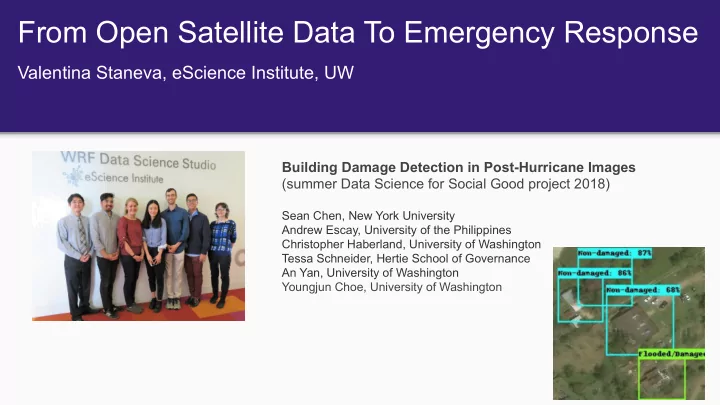

From Open Satellite Data To Emergency Response Valentina Staneva, eScience Institute, UW Building Damage Detection in Post-Hurricane Images (summer Data Science for Social Good project 2018) Sean Chen, New York University Andrew Escay, University of the Philippines Christopher Haberland, University of Washington Tessa Schneider, Hertie School of Governance An Yan, University of Washington Youngjun Choe, University of Washington
The Problem http://blog.digitalglobe.com/news/team-rubicon-uses-digitalglobe Flooding on the outskirts of Houston, Texas, August 31, 2017 (Photo credit: South -technology-to-aid-houston-residents-after-hurricane-harvey/ Carolina National Guard) https://www.planet.com/insights/anatomy-of-a-catastrophe/
Multiview Approach
Digital Globe Open Satellite Data 3 TB of image data ➢ ➢ Missing data, missing bands Clouds ➢ ➢ Crowdsourced manual annotations in JSON (Tomnod)
NOAA Public Aerial Data 400GB of image data ➢ ➢ No clouds
Damage Annotations FEMA v. TOMNOD
Building Footprints Oak Ridge National Labs
Building Footprints Microsoft
Object Detection (A Deep Learning Approach) ● Faster R-CNN (Ren et al., 2015) ● Single Shot MultiBox Detector (SSD) (Liu et al., 2016) TOMNOD damage predictions with SSD NOAA damage predictions with SSD
Data Processing Pipeline
Set of all alternatives
Set of all alternatives
Set of all alternatives
Set of all alternatives
Set of all alternatives
Set of all alternatives
Set of all alternatives
Set of all alternatives
Results (Average Precision) Alternative Flooded/Damaged Non-damaged Evaluation Score (mAP) SSD on 0.47 0.62 0.55 Satellite Imagery SSD on 0.32 0.65 0.48 Aerial Imagery Faster R-CNN 0.31 0.61 0.46 Satellite Imagery How can we represent the uncertainty to emergency responders?
Evaluation Human-labeled data Predicted output Flooded/Damaged Identify Flooded Buildings
Evaluation Human-labeled data Predicted output Flooded/Da maged Identify Damaged Buildings (Blue Tarp)
Evaluation Human-labeled data Predicted output Flooded/Damag ed Identify Damaged Buildings
Computational Infrastructure Hyak University Cluster: Downloading, Compressing and Tiling Pros: Cons: ● easy to experiment as not charged for every action ● no root access: ○ best to install Python packages through conda ○ Some geospatial libraries conda distributions don’t have full functionality ○ no docker support Amazon Web Services: Deep Learning Pros: Cons: ● can use pre-built images: great for deep learning ● everybody needs to learn about security management ● can save snapshots of all the work ● uploading data is free, but exporting and GPU ● can use GPUs without dealing with hardware and drivers computations are expensive ● can use managed databases Local QGIS server: Joins and Manual Inspection Pros: Cons: ● easy to see ● not reproducible
Sharing is Caring Datasets: ● Compressed and tiled dataset ● Training Dataset ● PostGIS SQL database with geospatial data ● Pickled trained models Cloud Backup: ● AWS S3 bucket ● Snapshots for instances + database Code on GitHub: https://github.com/DDS-Lab/ Website: https://dds-lab.github.io/disaster-damage-detection/
Objectives: Build an interdisciplinary community of users of satellite/aerial imagery ● Apply state-of-the-art approaches for large scale data processing and computer vision ● Develop software tools and advance the methodology in the remote sensing field ● Activities: ● Computational Workflow Demos, Tutorials, Hackatons, Networking Join us remote_sensing@uw.edu! https://uwescience.github.io/sat-image-analysis/ Valentina Staneva: vms16@uw.edu and Amanda Tan: amandach@uw.edu
Recommend
More recommend